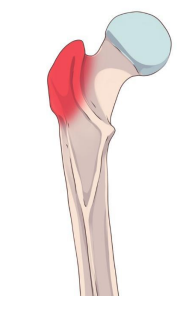Twenty-five years ago on a Friday night, I was playing in a high school basketball game. My teammate, one of our opponents, and I all jumped up simultaneously reaching for the basketball as it bounced off the rim. My teammate got the rebound; however, our opponent landed awkwardly on her back. Crashing to the floor, she landed on her left hip with a loud THUD! She squirmed and rolled around the court in severe pain. Some of the players tried to help her to the bench, but as she stood on her feet, she screamed even louder in pain. Eventually, EMS arrived and took her to the ER.
When our teams played again a few weeks later, the small forward that was injured in the previous game was still using her crutches to walk. Some of the players who helped her off the court asked her how she was feeling. She replied that she was still recovering from a hip pointer.
What is a hip pointer?
● A hip pointer is a contusion (bruise) to the iliac crest, the surrounding soft tissue, or the greater trochanter of the femur.
● Typically, there tends to be a small amount of fatty tissue making this area susceptible to injury from direct impact trauma from a fall.
● Impact to the hip can cause a hematoma that often leads to bleeding into the abductor muscle, thereby creating increased tenderness in the area.
● Pain and swelling will limit the range of motion in the hip; however, hip flexors and motor strength will remain intact.
● A patient with a hip pointer is at risk for recurrent injury.
How do hip pointers occur?
● Hip pointer injuries can result from falls onto the side of the hip(s).
● They can occur during contact sports (football, rugby, hockey, and basketball) and non-contact sports (volleyball).
Signs and symptoms
● debilitating pain and tenderness on the side of the hip
● a sudden onset of hip pain in the iliac crest or greater trochanter regions after a fall or hit to the area
● swelling
● the presence of a burning sensation
● decreased hip range of motion (ROM) at the hip and abdominal area
● a limp when walking
If you suspect a possible hip pointer injury, follow-up with your physician or general practitioner for a physical exam.
Diagnosis
● X-rays of the hip to rule out fractures
● computer topography (CT) scan if pain continues and to assess soft tissue for a definitive diagnosis.
Treatment
● ice packs to the affected side
● NSAIDs for pain and swelling
● rest of the affected hip until symptoms improve
Once pain decreases in the affected side of the hip, ROM and activity will increase.
o This is the time physical therapy (PT), such as stretching and walking as tolerated, will begin.
o As pain and swelling continue to lessen and allow normal ROM, patients may return to physical activity.
o Most injuries improve with non-operative treatment.
o If pain persists for over 2 weeks, an orthopedic consult may be necessary.

References
Lombardi, N. J., Tucker, B., Freedman, K. B., Austin, L. S., Eck, B., Pepe, M., & Tjoumakaris, F. P. (2016). Accuracy of Athletic Trainer and Physician Diagnoses in Sports Medicine. Orthopedics, 39(5), e944–e949. https://doi.org/10.3928/01477447-20160623-10
Marta, T. (2021). [Diagram]. Greater trochanter. The femur, or thigh bone, is the proximal bone of the hindlimb in tetrapod vertebrate, the largest bone of the human body. https://www.shutterstock.com/image-illustration/greater-trochanter-femur-thigh-bone-proximal-1864502293
Martinez, J. (2021). Hip Pointer. https://emedicine.medscape.com/article/87322-followup
